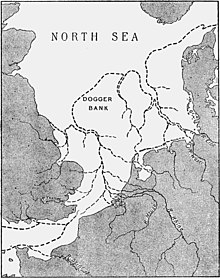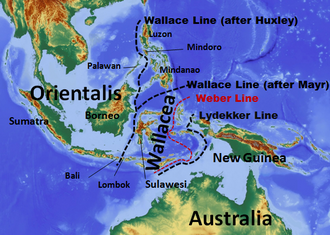Land bridge hypothesis

Landbridge hypotheses were a widely used method in paleogeography in the 19th and early 20th centuries .

The attempt was made to explain the disjoint , geographically different distribution of closely related plant and animal species , which was already apparent at the time , through former land connections that had in the meantime fallen dry or rose above sea level. The raising and lowering of individual crust areas was considered to be much more likely than a horizontal shift against one another or, in the case of a ceiling , one above the other.
Even global land bridge hypotheses were widespread in the 19th and early 20th centuries. They were postulated on a large scale and gave rise to a veritable wave of speculation about sunken continents with formerly prosperous civilizations. They also inspired popular science works as well as esotericism, popular culture and literature. With the recognition of plate tectonics and the increasingly precise geological age determination , they lost their importance.
requirements
So-called fixism was widespread in geotectonics and global geodynamics until the 20th century . According to this, the earth's continents were horizontally immobile, structure-forming processes in the lithosphere mainly took place vertically, through uplift and downward movement. The cooling or shrinking theory of the earth was considered to be an essential driver of such processes of earth development and mountain formation . Measurements of the balance of gravity and the corresponding lifting effects were already possible in the 18th century. Charles Lyell identified them on the Scandinavian shield, among other things, and assumed that such effects played a role worldwide and in the entire history of the earth. The temporal allocation within the geological time scale was only relatively possible before the discovery of absolute age determination methods in geology and archeology , the duration of the geological ages immediately before the present was clearly overestimated well into the 20th century.
Biogeography, which, on the other hand, was still in its infancy, largely uncritically adopted the idea of raising and lowering large land masses. According to Matthias Glaubrecht , the rather skeptical Darwin had dismissed the arbitrariness of some Landbridge hypotheses with the remark that they are as easy to construct as a cook makes pancakes. Biogeography has long tried to make a static division into biotic districts and sub-regions. The early scientific work also gave the Landbrücken a role in biographical and ethnographic distribution.
Biogeographical Studies


Essential biogeographical research on the subject came from Alfred Russel Wallace and Philip Lutley Sclater , for example the so-called Wallace line as the biogeographical dividing line between the Asian fauna ( Orientalis ) and the Australian fauna ( Australis ). One challenge was the different mobility of different species. Alfred Russel Wallace himself gave the distribution of the species a more important role by spreading on land even over long distances and by transporting them to floating debris.
Emmett Reid Dunn and George Gaylord Simpson began again in the middle of the 20th century with more statistical evaluations based on individual animal species. Simpson spoke of filter bridges or corridors that were only accessible to certain types.
Wegener's plate tectonic hypothesis
Plate tectonics had already been supported by several biogeographers with Alfred Wegener's first publications after 1915, but initially especially for phenomena of the Pleistocene and Quaternary , i.e. the recent geological past, which is similar to Wegener's proposed mechanism and because of the actually much slower timing of the Shifts turned out to be unsustainable.
The idea of the land bridges was so powerful that Wegener's theses were not recognized for a long time. In 1939 the annual meeting of the German Geological Association was still under the motto “The Atlantis Question”; Hans Cloos had thus addressed the problem of whether continental crust fields had sunk in the Atlantic Ocean or whether Wegener's drift hypothesis was correct. At that time, a majority was still in favor of the Landbrücke and against Wegener's hypothesis. Furthermore, essential arguments in favor of Wegener and against the land bridges could later be worked out from an overview of the biogeographical findings; at the time of Wegener, however, a corresponding synopsis was not yet available due to research controversies and coordination problems . According to Ernst Mayr , the resistance of many biogeographers against Wegener was initially justified and well-founded. In the 1960s there was a renewal of plate tectonics, which provided useful results, particularly for the Cretaceous and Jurassic, but still poses questions.
Regional land bridges
At times, a Lusitanian land bridge in between was assumed for various animal species that are common in both northern Portugal and southern Ireland. Later, however, the distribution in this case turned out to be a consequence of the earliest human settlement.
The Doggerland between England and Germany was already identified by Clement Reid at the end of the 19th century as a former, presumably Ice Age land bridge between Great Britain and the continent. In 1931 there was more intense interest due to Mesolithic finds. More recent research, among others since 1998 by Bryony Coles, see it as an independent Mesolithic settlement area of supraregional importance, no longer as a pure land bridge. Further land bridges and significantly extended coastal areas were suspected and partially identified in the vicinity of Wales and the Irish Sea . The culture on the Doggerland was probably hit by a tsunami triggered by the Storegga slide in 6200 BC and the land bridge was interrupted at the latest when the Agassizsee drained into the Atlantic Ocean.
Global land bridges

On a continental scale, Adolphe Brongniart noticed related Glossopteris ferns in India and Australia as early as 1828 . In 1859 these were also found in South Africa and in 1895 in South America as well. Therefore, for this Glossopteris flora, a southern major continent Gondwana was assumed. The various studies, for example by Joseph Dalton Hooker on southern beeches or Ludwig Rütimeyer on the recent fauna and various fossils of South America, South Africa and Australia, solidified this assumption.
At the end of the 19th century, these ideas became increasingly popular. By Philip Sclater was from today's proliferation lemurs on a former continent Lemuria closed, Madagascar and India should have joined. The evolutionary biologist Ernst Haeckel speculated in his popular Natural Creation Story (1868) about such a sunken land bridge between Madagascar and India as the geographical origin of man . A similarly closed and popular scientific form can be found in Eduard Suess ' Antlitz der Erde from 1883. Haeckel also used Lemuria to interpret many missing links in evolutionary history - these went under with this land bridge.
Hermann von Ihering assumed a land bridge called Archhelenis between South Africa and South America in 1890 and expanded this idea in his popular History of the Pacific Ocean in 1927 to include a connection called Archatlantis between North Africa and Florida and the Antilles , including the Azores , Canaries and Cape Verde . In 1922 Theodor Arldt presented a manual of palaeogeography in which he summarized various land bridges. In 1939 the thesis was available in the Atlas de paleobiogéographie by Léonce Joleaud . The natural scientific land bridge hypotheses gave rise to further, ideologically justified speculations in which the remains of once high-ranking civilizations were suspected on such land bridges. In addition to the Atlantean myth, Lemuria and the continent Mu in the Pacific were thematized accordingly and searched for with considerable effort.
Examples
In the context of the theory, the following were incorrectly postulated:
- Archatlantis from the West Indies to North Africa
- Archhelenis Brazil to South Africa
- Archigalenis from Central America via Hawaii to Asia
- Archinotis from South America to Antarctica
- Lemuria in the Indian Ocean
Individual evidence
- ↑ a b c On the European tradition of the lost continents. In: Franz Winter: Hermes and Buddha: the new religious movement Kofuku no kagaku in Japan. LIT Verlag, Münster 2012, ISBN 978-3-643-50381-7 , p. 213 ff.
- ↑ Matthias Glaubrecht : Wegener's new worldview. The emergence of the continental drift theory. ( Memento of the original from March 3, 2014 in the Internet Archive ) Info: The archive link was inserted automatically and has not yet been checked. Please check the original and archive link according to the instructions and then remove this notice. Part 1. In: Naturwissenschaftliche Rundschau. 65 (6), 2012, pp. 288-296.
- ↑ a b c d e f g The development of the biological world of thought: Diversity, evolution and inheritance, Ernst Mayr, Springer DE, June 6, 2002, p. 360 ff
- ↑ a b c d Matthias Glaubrecht: Wegener's new worldview. The emergence of the continental drift theory. ( Memento of the original from March 3, 2014 in the Internet Archive ) Info: The archive link was inserted automatically and has not yet been checked. Please check the original and archive link according to the instructions and then remove this notice. Part 2. In: Naturwissenschaftliche Rundschau. 65 (7), 2012, pp. 341-352.
- ↑ On earlier land bridges, migrations of plants and peoples between Australasia and America, Johannes Gottfried Hallier 1912
- ↑ On the theory of land bridges and the viscosity of the earth, Adalbert Prey , Springer-Verl., 1947
- ↑ Compare rejection of Wegener's theses still in 1962 in the Handbuch der Zoologie / Handbook of Zoology Volume 8: Mammalia Lfg 28 Spread of Mammals in Prehistoric Times, Part 28, HW Matthes, Walter de Gruyter, 1962, p. 183
- ↑ Helmut W. wing: Wegener-Ampferer-Schwinner: A contribution to the history of geology in Austria . In: Mitt. Österr. Geol. Ges . tape 73 , December 1980.
- ↑ B. Schäfer: On the problem of the "Lusitan" flora and fauna elements in Ireland. Were the first Irish Portuguese? In: Ber. Inst. Landscape Plant Ecology Univ. Hohenheim. Issue 14/15/16, 2004-2006.
- ↑ Laura Spinney: Archeology: The lost world. In: Nature. 454 (2008), pp. 151-153, doi : 10.1038 / 454151a .
- ^ Bryony Coles: The Doggerland project. Project description from the University of Exeter
- ↑ doggerland. The University of Birmingham on Doggerland and other research, including in Wales 2013.
- ^ Bernhard Weninger et al .: The catastrophic final flooding of Doggerland by the Storegga Slide tsunami. ( Memento of the original from October 11, 2010 in the Internet Archive ) Info: The archive link was inserted automatically and has not yet been checked. Please check the original and archive link according to the instructions and then remove this notice. In: Documenta Praehistorica. XXXV, 2008.
- ↑ James Scourse: Quaternary Sea Level and Palaeotidal Changes: A Review of Impacts on, and Responses of, the Marine Biosphere. In: RN Hughes, DJ Hughes, IP Smith (Eds.): Oceanography and Marine Biology: An Annual Review. Volume 51, August 28, 2013, CRC Press, p. 22 ff.
- ↑ Erich Thenius : Das Gondwana-Land "Eduard SUESS 1885 The Gondwanakontinent from an earth and bioscientific perspective. In: Mitteilungen der Österr . Geol. Ges. 74/751 981, Vienna 1981, pp. 53–81.
- ^ Ted Neild: Supercontinent: Ten Billion Years in the Life of Our Planet . Harvard University Press, 2007, ISBN 978-0-674-02659-9 , pp. 38-39.
- ↑ Ernst Haeckel: The natural history of creation . 1868, (online: Chapter 19 )
- ↑ a b c d Up-and-Down Landbridges. In: William R. Corliss : Mysteries Beneath the Sea. Apollo Editions, 1975, ISBN 0-8152-0373-X .
literature
- PJ Darlington, Jr .: What about Archatlantis? In: The American Naturalist. Vol. 72, No. 743 (Nov-Dec, 1938), pp. 521-533.
- Joachim Illies , The Wegener continental drift theory in the light of modern biogeography. In: Natural Sciences. Volume 52, edition 18 / January 1965, pp. 505–511, doi : 10.1007 / BF00638342

